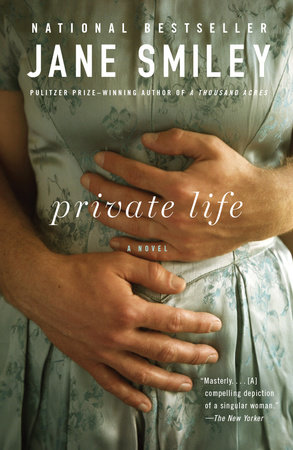Reading Group Center
- Home •
- Books by Category •
- Imprints •
- News •
- Videos •
- Media Center •
- Reading Group Center
Jane Smiley Discusses The Lives Behind Private Life
Private Life is the story of one woman’s life, from post Civil-War Missouri to California in the midst of World War II. In our interview, author Jane Smiley discusses how Margaret Mayfield originated from her own family tree and how she drew a line between the novel’s historical and fictional fictional elements.
Q: Some of the characters in Private Life are based in part on members of your own family—your main character Margaret Mayfield on your great aunt, Frances See and Andrew Early on her infamous scientist husband Thomas Jefferson Jackson See, a naval astronomer whose increasingly implausible theories made him an outcast in the scientific community. Did you ever meet them?
A: I didn’t know my aunt at all, or her husband. She died when I was about two or three. She was my grandfather’s much older sister—he was the youngest of ten children and she was number two or three. But my mother and her siblings were quite fond of her. As for her husband, they thought he was just an eccentric family uncle, and I don’t think they realized how infamous he was in the physics establishment.
Q: How much of Margaret and Andrew draw from your aunt and uncle’s actual experience and how much is purely fictional?
A: There were only a few family stories that revealed personal details about them—for example that she drove an elderly Franklin and had a good sense of humor. My mother had visited her in the nineteen-forties, I think, and she remembered that my aunt loved Oriental art (a trait she shares with my character Margaret Mayfield). But almost everything else about Margaret is made up. I could not seem to get her sense of humor into the novel—the material was just too dark for me. My uncle is more famous, and there were plenty of stories about him—almost all of them revealing him as appallingly egomaniacal and obsessed. There was an article about him in a physics journal which described him, essentially, as the kind of scientist you were not supposed to be.
The important thing to remember is that Margaret and Andrew take some of their inspiration from these real people, but the story about them—that is, the plot of the novel—is entirely made up by me. All of the other characters and all of the events of the novel are fictional. For me, the center of the idea was in wondering what it would be like to be married to someone like Andrew, but there was no family evidence to say how my great-aunt felt about it. Just as one example, I had to prune both Margaret’s and Andrew’s family trees—both had countless brothers and sisters that would overwhelm a 300-page novel. I also had to concoct a fascinating mother for Andrew—but Mrs. Early is a theory on my part, not a portrait of anyone related to Thomas Jefferson Jackson See. While I was working on the novel, I thought of Henry James, and his fear of “developments”—that the inspiring material would proliferate and get out of control.
I was also interested in the idea of Missouri and St. Louis at the end of the 19th century, after the Civil War and around the time of the World’s Fair. St. Louis is a beautiful but strange city. Because of climate and epidemics of disease, in the mid-19th century, it was considered one of the worst places in the U.S. to live, but it was actually very cosmopolitan and self-satisfied, with beautiful architecture and thriving commerce. Right in the center of things for some decades.
Q: Did you have to do any research into their lives? Into the science and astronomy that Andrew studies? Or the historical events this novel spans?
A: I visited their house in Vallejo and also Mare Island, where the U.S. Navy had a base and a ship-building yard from about 1850 through the Second World War, twice, and I also read about See. His Moon Capture theory was included in a book about the moon that was published a few years ago. He is a presence on the Web, but he is still considered too “Newtonian” to be respected for anything. The scandals in Dr. Andrew Early’s life are somewhat similar to the scandals in Dr. See’s life. The key for me was in trying to see things through his point of view—to make a logic system that made sense to him even though it didn’t make sense to anyone else. I think that it is easy for a novelist to understand a conspiracy theorist—the story gets bigger and bigger, and it all just fits together in one’s mind. The person creating the story simply cannot understand why it doesn’t make sense to others. I think the most telling article for me was a piece See published in the San Francisco Examiner called “The Ether Exists and I Have Seen It.” The article was from about 1925, and included six pointed figures See had drawn. Even to an English major like me, this was absurd. However, I think that if he were still alive, he would insist that he had predicted the discovery of Dark Matter.
Click to read the rest of our interview with Jane Smiley! Plus, download our reading group guide, read an excerpt from the book, and schedule a phone chat with the author.


